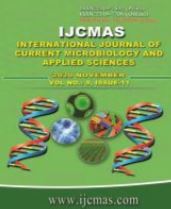


 National Academy of Agricultural Sciences (NAAS)
National Academy of Agricultural Sciences (NAAS)

|
PRINT ISSN : 2319-7692
Online ISSN : 2319-7706 Issues : 12 per year Publisher : Excellent Publishers Email : editorijcmas@gmail.com / submit@ijcmas.com Editor-in-chief: Dr.M.Prakash Index Copernicus ICV 2018: 95.39 NAAS RATING 2020: 5.38 |
Papaya ring spot disease caused by papaya ringspot virus (PRSV) is the major limiting factor in papaya growing regions in Maharashtra. In these study chemicals inducing resistance was assessed in in vitro condition against PRSV. Eight chemicals which didn’t show any phytotoxicity (Chitosan, 6-Benzyladenine, Salicylic acid, IAA, IBA, NAA, Humic acid, Trisodium phosphate) inducing resistance were tested at different concentrations. The eight chemicals inducing resistance exhibited variable response in three modes of applications viz., seed soaking, pre inoculation spraying and post inoculation spraying. Among the chemicals tested, none was found efficient in inducing complete resistance against PRSV, but they increased the incubation period thereby delaying the symptom expression, as compared to control. The maximum incubation period was observed in spraying of Chitosan, at 72 hours prior to virus inoculation, which was most effective in reducing PRSV disease incidence in papaya. In seed soaking application, lowest PRSV incidence was recorded in Trisodium phosphate treatment while, by spraying of chemicals at 72 hrs. pre- and post-inoculation, the lowest PRSV incidence was recorded in humic acid treatment. All the chemical treatments delayed the symptoms expression as compared to control treatment. Pre-inoculation chemicals were the best gave the most effective control and Chitosan, 6-Benzyladenine, Salicylic acid, were the best treatments. Though all the chemical treatments enhanced the plant height of papaya, but with the chemicals viz., Salicylic acid, 6-Benzyladenine and Trisodium phosphate applied as seed treatment, there was no significant increase in plant height and same is the case with Naphthalene acetic acid and indole-3-acetic acid applied 72 hrs. prior and after inoculation.
 |
 |
 |
 |
 |